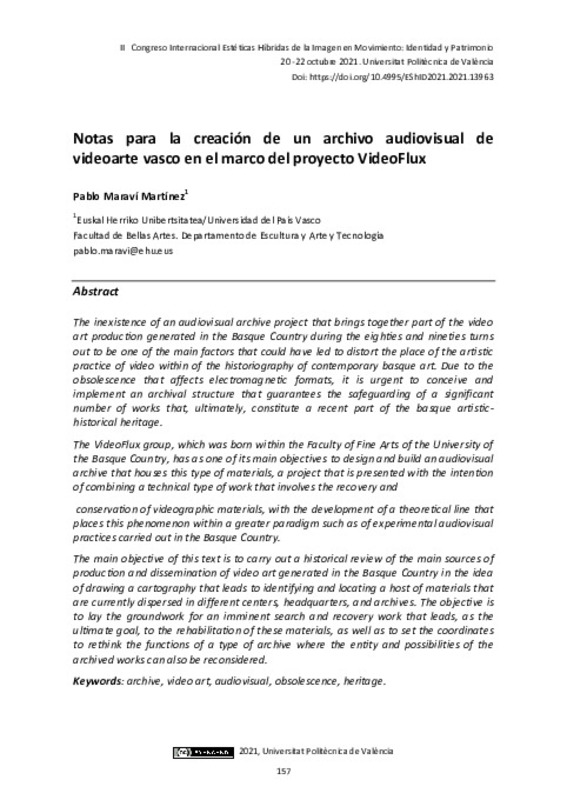|
Resumen:
|
[EN] The inexistence of an audiovisual archive project that brings together part of the video
art production generated in the Basque Country during the eighties and nineties turns
out to be one of the main factors that ...[+]
[EN] The inexistence of an audiovisual archive project that brings together part of the video
art production generated in the Basque Country during the eighties and nineties turns
out to be one of the main factors that could have led to distort the place of the artistic
practice of video within of the historiography of contemporary basque art. Due to the
obsolescence that affects electromagnetic formats, it is urgent to conceive and
implement an archival structure that guarantees the safeguarding of a significant
number of works that, ultimately, constitute a recent part of the basque artistichistorical heritage.
The VideoFlux group, which was born within the Faculty of Fine Arts of the University of
the Basque Country, has as one of its main objectives to design and build an audiovisual
archive that houses this type of materials, a project that is presented with the intention
of combining a technical type of work that involves the recovery and
conservation of videographic materials, with the development of a theoretical line that
places this phenomenon within a greater paradigm such as of experimental audiovisual
practices carried out in the Basque Country.
The main objective of this text is to carry out a historical review of the main sources of
production and dissemination of video art generated in the Basque Country in the idea
of drawing a cartography that leads to identifying and locating a host of materials that
are currently dispersed in different centers, headquarters, and archives. The objective is
to lay the groundwork for an imminent search and recovery work that leads, as the
ultimate goal, to the rehabilitation of these materials, as well as to set the coordinates
to rethink the functions of a type of archive where the entity and possibilities of the
archived works can also be reconsidered.
[-]
[ES] La inexistencia de un proyecto de archivo audiovisual que aglutine parte de la producción de videoarte generada en Euskal Herria durante las décadas de los ochenta y noventa resulta ser uno de los principales factores ...[+]
[ES] La inexistencia de un proyecto de archivo audiovisual que aglutine parte de la producción de videoarte generada en Euskal Herria durante las décadas de los ochenta y noventa resulta ser uno de los principales factores que ha podido llevar a distorsionar el lugar de la práctica artística del vídeo dentro de la historiografía del arte contemporáneo vasco. Debido la obsolescencia que afectan a los formatos de tipo electromagnético, urge idear y poner en marcha una estructura archivística que garantice la salvaguarda de un importante número de obras que, en definitiva, constituyen una parte reciente del patrimonio artístico-histórico vasco. El grupo VideoFlux, el cual nace en el seno de la Facultad de Bellas Artes de la Universidad del País Vasco, tiene como uno de sus objetivos principales el de diseñar y construir un archivo audiovisual que albergue este tipo de materiales, un proyecto que se presenta con la intención de compaginar un trabajo de tipo técnico que implique labores de recuperación y conservación de materiales videográficos, con el desarrollo de una línea teórica que sitúe a este fenómeno dentro de un paradigma mayor como es el de las prácticas audiovisuales experimentales realizadas en Euskal Herria. Este texto tiene como principal objetivo el de realizar un repaso histórico por los principales focos de producción y difusión de videoarte generado en Euskal Herria en la idea de trazar una cartografía que permita identificar y localizar un cúmulo de materiales que yacen actualmente dispersos en distintos centros, sedes y archivos. El objetivo es el de sentar las bases para un inminente trabajo de búsqueda y recuperación que conduzca, como fin último, a la rehabilitación de dichos materiales, así como establecer las coordenadas para repensar las funciones de un tipo de archivo donde la entidad y posibilidades de los materiales archivados puedan ser también replanteadas.
[-]
|








